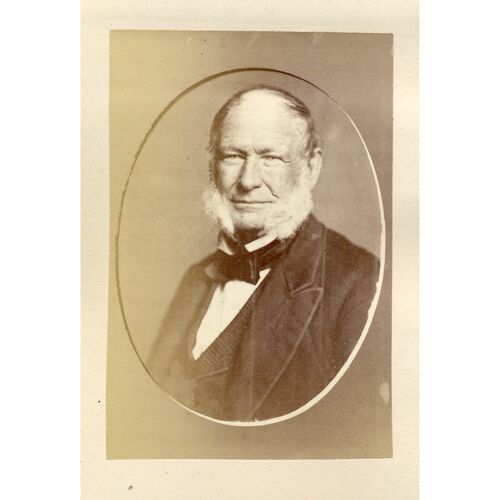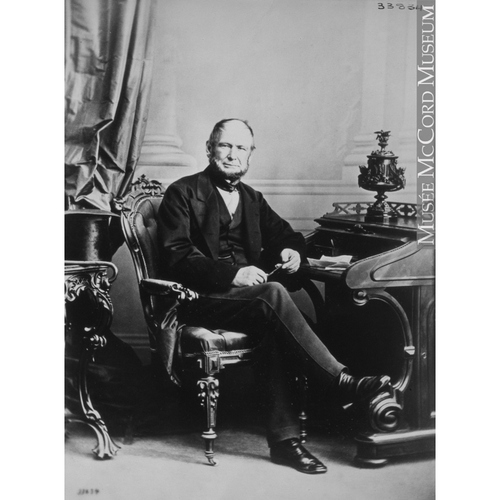STEPHENS, HARRISON, merchant; b. 17 Oct. 1801 at Jamaica, Vt, son of Samuel Stephens and Beulah Howard; m. 22 Feb. 1824 or 1825 Sarah Jackson, and they had three sons and two daughters; d. 16 May 1881 at Montreal, Que.
Harrison Stephens was educated at the district school in Jamaica, Vt, and at the academy in Middlebury. As a young man he worked as a sub-contractor on the canal system near Whitehall, and as a bootmaker in a tannery in Hubbardton. He later owned a small shoe factory in Swanton before moving in 1825 to Missisquoi Bay, Lower Canada, where he operated a large tannery. Two years later he relocated in either Bedford or Stanbridge and opened a sizeable boot and shoe factory. By the early 1830s he had settled in Montreal, where he had begun a business importing rice and tobacco from New York State; in it he had had a brief partnership with a fellow American, Edward Kellogg. Stephens might also have owned a hotel when he arrived in the city.
Although no records of his various enterprises survive, Stephens is known to have prospered immensely. According to a colleague, Jedediah Hubbell Dorwin, he “made the most rapid fortune of any merchant in Canada.” By 1830 he was wealthy enough to have a large deposit in the Bank of Montreal. In spite of the size of his account, it was said that the bank’s president, Peter McGill [McCutcheon*], refused to discount his notes, probably because Stephens was an American. Undaunted, Stephens began to withdraw large amounts: one draft was over $150,000. He took the money to New York by sleigh and earned 2 per cent on the transaction. Stephens’ sudden and drastic action prompted John Torrance*, a director of the bank, to negotiate with Stephens on behalf of the institution. Stephens agreed to stop withdrawing his money, probably as a personal favour to Torrance. His relationship with the bank steadily improved thereafter and in 1845 he was elected a director; he served in that capacity until 1857.
By the mid 1830s or early 1840s Stephens had formed a new partnership with his brother, Sheldon, and John Young*. Stephens, Young and Company dealt principally in staples. Stephens recalled that in one year alone he sold 5,000 to 6,000 hogsheads of rum, a “common drink of the country,” and the firm also dealt in vast quantities of flour and pork, having on hand up to 50,000 barrels of each at a time. Indeed, Stephens and Young, acting in conjunction with the New York firm of Hubbard and Company, claimed to control the Canadian pork market for most of this period. After conducting an extremely successful trade, Stephens dissolved his partnership with Young in 1846 and not long afterwards retired from the import business. Young entered a new partnership with Benjamin Holmes*, former cashier (general manager) of the Bank of Montreal.
Stephens was never involved in politics at any level, but not for lack of interest. Towards the end of his life he revealed that the reason he did not join Louis-Joseph Papineau* in 1837 was that he felt vulnerable because of his American birth. He knew Papineau well, remembering him as “a very kind-hearted patriotic statesman” and recalling that “the people had very considerable reason [for] . . . the Revolution of ’37.” “In those days there was a great deal of misgovernment . . . [but I] positively refused to offer any assistance to Papineau . . . and supported the . . . Government as it stood, because if I did not, I felt it was no place for me here. . . .” Stephens did take an active part, however, in the protectionist – free trade controversy that rocked the Montreal business community during the late 1840s. Aggravated by the free trade views of Young and a small group of local merchants, the Montreal protectionists formed a branch of the British American League [see George Moffatt*], of which Stephens was one of the vice-presidents. He was also a member of the group that waited on Louis-Hippolyte La Fontaine* in 1850 to press for higher tariffs. Deeply moved by the plight of his native country at the outset of the American Civil War, Stephens offered to raise at his own expense a regiment of men at nearby Rouses Point, N.Y., to fight under the command of Montreal’s Colonel Frederick William Ermatinger* for the government of the United States. For undetermined reasons the offer was declined by the secretary for war.
Although retired from commercial affairs after 1846, Stephens was involved in numerous other business ventures. He acquired vast real estate holdings in Montreal, especially in the business section around St James Street (Rue Saint-Jacques), and he was believed to be the largest property owner in the city; he paid approximately the same amount of property tax as the Grand Trunk Railway. Stephens was listed among the promoters of the St Lawrence and Atlantic Railroad, the Caughnawaga canal [see John Young], the Montreal Railway Terminus Company, and the Merchants’ Bank (of which he was one of the provisional directors in 1861), but he seems to have remained at most a shareholder in each. In addition he was one of the incorporators of the Montreal Board of Trade in 1841 and the Montreal Protestant House of Industry and Refuge in 1863. He is also mentioned as having been involved in at least one construction project, a new business premises for Henry* and James Morgan in 1866.
Stephens lived with his wife and children in his elegant home on Dorchester Street surrounded by three acres of manicured lawns and shrubs overlooking the city. He was a Unitarian, as were several other prominent Montrealers, including Sir Francis Hincks, Benjamin Holmes, Thomas Workman, and John Young. A person who neither smoked nor drank, he was regarded as “a man of excellent moral character.” In his will he left a generous endowment of $2,000 to both the Church of the Messiah and the Montreal General Hospital.
A “Biography of the late Harrison Stephens” is in the possession of Murray Ballantyne, Westmount, Que. AC, Montréal, État civil, Unitariens, Messiah Unitarian Church (Montreal), 19 May 1881. McCord Museum (Montreal), J. H. Dorwin, “Antiquarian autographs,” 103, 393. Canadian biog. dict., II: 347. Dominion annual register, 1880–81: 430. Terrill, Chronology of Montreal. Denison, Canada’s first bank, II. Tulchinsky, River barons.
Cite This Article
Gerald J. J. Tulchinsky, “STEPHENS, HARRISON,” in Dictionary of Canadian Biography, vol. 11, University of Toronto/Université Laval, 2003–, accessed December 23, 2025, https://www.biographi.ca/en/bio/stephens_harrison_11E.html.
The citation above shows the format for footnotes and endnotes according to the Chicago manual of style (16th edition). Information to be used in other citation formats:
| Permalink: | https://www.biographi.ca/en/bio/stephens_harrison_11E.html |
| Author of Article: | Gerald J. J. Tulchinsky |
| Title of Article: | STEPHENS, HARRISON |
| Publication Name: | Dictionary of Canadian Biography, vol. 11 |
| Publisher: | University of Toronto/Université Laval |
| Year of publication: | 1982 |
| Year of revision: | 1982 |
| Access Date: | December 23, 2025 |


![[Harrison Stephens] [image fixe] / Studio of Inglis Original title: [Harrison Stephens] [image fixe] / Studio of Inglis](/bioimages/w600.5058.jpg)


